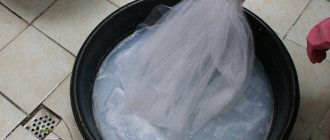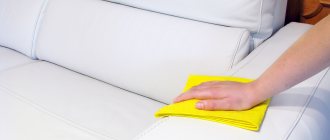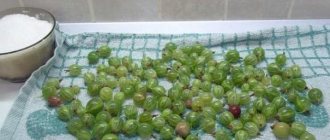Everyone knows how to iron curtains, but not everyone may know how to do it correctly with different fabrics. How to straighten curtains while hanging with a steamer or an iron? The correct, competent application of useful knowledge will help not to spoil the curtain with a burn from the iron, which is then very difficult to remove from the surface of any fabric.
Beautiful folds, smooth and even fabric delight the eye and lift your spirits
Hanging crumpled curtains is unthinkable - it’s like putting on an unironed dress
Is it possible to iron curtains with an iron?
Most of the materials from which curtains are made are iron-resistant. To prevent the smoothing process from becoming a torment, you need to arrange your work area using one trick:
- Place the ironing board next to the window.
- Iron the top.
- Hook it on the ledge.
- Continue ironing the bottom.
The method speeds up ironing and is applicable to various curtains, but is most suitable for those that wrinkle easily. Firstly, the fabric on the ironing board does not need to be constantly maintained, secondly, this way you can prevent the occurrence of unwanted folds.
What iron setting should you use to iron?
A weakly heated device will not create problems: you will simply be left with a crumpled curtain. Another thing is an iron heated to extremely high temperatures. One touch, and you will ruin the curtain, and then your own mood.
It is important not to confuse the ironing mode by correctly deciphering the meaning of the symbol on the curtain or fabric label:
| Number of points on the iron thermostat: | Permissible temperature: |
| 3 | up to 200°C |
| 2 | no higher than 150°C |
| 1 | allow heating up to 110°C |
The crossed out iron icon means that ironing, including steam, is prohibited.
Maximum numbers are not scary, as a rule, for natural materials, including cotton and linen. The work will go faster if you iron a curtain that is not completely dry, or a curtain that is dry but through damp gauze. A good old way is to spray with water from a spray bottle.
The most capricious are polyester and viscose, which melt under a hot iron. They are ironed from the inside out, first placing the iron on the edge of the curtain to check the degree of heating.
Common mistakes when ironing
There are a number of mistakes that housewives often make when ironing curtains.
You need to know them in order to prevent them from happening in the future:
- Incorrect temperature. If the curtains were purchased in a store, then the label indicates recommendations for the ironing mode. If they are made to order, you must ask the craftsman what fabric they are made of. When the material is unknown, first perform a test ironing in an inconspicuous place.
- Steaming. It is not suitable for all fabrics. Delicate materials cannot be steamed, because... they are easily deformed and lose their original appearance.
- Smoothing curtains with rhinestone embroidery on the front side. This can only be done from the inside out, otherwise the rhinestones will stick to the iron and the embroidery will lose its relief.
- Ironing without lining. If you iron them on the front side of the curtains without a lining, then waves and shine appear on the material, and the likelihood of burning through the fabric also increases.
Smoothing without iron
You can give curtains a sleek look in a variety of ways, such as hanging them over a bathtub filled with hot water (with the door closed tightly). This steaming takes 20-30 minutes, then the fabric is straightened by hand, attached to the curtain rod and left until completely dry.
The second method resembles the first, but excludes the bath step:
- The wrung out, but moderately damp curtains are fixed to the cornice.
- Severely sagging fabric is lifted and attached to the crossbar.
- If the curtain wrinkles a little, it is wrapped a couple of times around the cornice.
- The drying curtain is gradually unrolled and lowered.
- The bruises are carefully straightened out, smoothing them with your hands.
- It takes up to 12 hours for massive curtains to dry.
The damp fabric straightens out under its own weight, which makes it possible to do without an iron.
The type of material dictates the rules
Each interior style dictates its own design rules. A large number of materials and design solutions allows you to choose the optimal curtain model for each room:
We suggest you familiarize yourself with How to remove an emblem from clothing
| Type of material | Ironing Features |
| Viscose or polyester | Curtains made of polyester and viscose do not attract dust and do not stretch during use. They can be ironed at low temperatures - no more than 150ºС. The steam function should not be used in this case. The iron is moved carefully, without stopping in one place. |
| Cotton or linen | Natural linen and cotton products allow the use of high iron heating temperatures. In order for the material to be smoothed, it must be slightly damp. If the curtain is already completely dry after washing, it must be moistened and ironed using steam. You can also iron with an additional damp cloth. |
| Organza or chiffon | After washing, such curtains can be immediately hung on the curtain rod when wet. But if the fabric is very wrinkled, then it can be smoothed through tissue paper at a minimum temperature. The use of the steaming function, as well as high temperatures, is prohibited - the material may become deformed and develop unsightly waves. |
| Taffeta or silk | Ironing should be done from the inside out at a low temperature - up to 110ºС. You cannot use steam or moisten the material, as this can lead to the formation of stains and streaks. |
| Capron | The easy-to-care material allows you to do without ironing at all. If you hang a freshly washed curtain evenly, you can do without ironing. Temperature range – up to 110-150ºС. |
| Veil | Iron delicate fabrics only through additional fabric. The steam function is turned off. No force is applied during the ironing process. |
| Blackout | Thick, light-proof fabric does not require ironing after washing. If jammed areas appear, they can be removed with a low-heat iron. |
| Velvet or velor | Fabrics with a small short pile cannot be ironed in the usual way. After washing, the curtain is wrung out through a terry towel and dried. Velvet and velor should be ironed extremely carefully, turning the front side onto a spread terry towel. |
In addition to curtains made from one type of fabric, there are models made from a combination of materials, as well as double-sided ones.
For lined curtains, straightening must be done for both the inside and outside, changing the heating modes of the iron and selecting suitable processing conditions.
Smoothing with a steamer
This is how hanging curtains recently purchased or washed usually get rid of wrinkles. The more powerful the steamer, the more steam it generates, speeding up the work.
Look at the volume of the tank: if the tank is small, you will have to fill it with water 2-3 times if the curtains are wide and long.
A vertical steamer rarely needs an extension cord, which cannot be said about small household models. When choosing a mode, proceed from the composition of the fabric. A good device emits steam within 30-45 seconds. after switching on.
Curtains are ironed slowly, directing steam from the iron, repeating the movement several times if wrinkles remain. The fabric is worked from top to bottom, slightly stretching.
Steam without appliances
To iron curtains by weight, you do not necessarily need to use special equipment. You can use some knowledge. For example, you can remove all folds and wrinkles from the material by hanging wet curtains on a line in the bathroom, filling the bathtub with hot water and closing the door to the room.
About 20 minutes after the steam has exposed the fabric, all you have to do is hang the curtains directly on the curtain rod - they will stretch out and be even.
Important! If creases still remain, you can use steam from the kettle. Just boil water in it, place the spout directly under the crumpled fabric, hold for a minute or two, and that’s it - the curtains will be completely straightened.
How to straighten curtains without removing them from the curtain rod
If you haven’t had time to get a steamer, try a few other techniques approved by housewives.
Without iron
The method is applicable to synthetic, low-wrinkle materials. The washed curtains are hung over the bathroom, waiting for the water to drain, then they are returned to their usual place (window). Here they smooth it out with their hands, leaving it to dry, spreading old sheets or rags under them to absorb moisture.
Steam
Take a large container of boiling water and place it near the curtains hanging from the curtain rod. The steam will penetrate the fabric by weight, softening it and smoothing out unevenness.
You can enhance the steam effect by sprinkling water with a few drops of vinegar on the curtains or pressing wet gauze to problem areas. Finally, the curtains are straightened by hand.
Iron
In this case, it acts as a steamer. Proceed like this:
- Wear gloves to protect against burns.
- Fasten the damp curtains to the window so that they open slightly under their own weight.
- Straighten the creases by hand.
- Fill the iron (with steam function) with water and turn it on.
- Iron the curtains with steam, bringing the iron closer to 0.3-0.4 m.
Move the device from top to bottom. Steaming a thick curtain will take longer than steaming a thin curtain.
How to iron thick fabric
In this category, velvet is considered one of the most finicky: it is forbidden to wring it out or iron it when wet. Washed large curtains are wrung out using terry sheets.
The curtains are laid between the sheets, gently pressing them with your hands. The less you wrinkle the velvet, the easier it will be to iron.
Do not touch velvet with an iron if the fabric is not completely dry, but iron it exclusively along the pile.
In order not to spoil the luxurious appearance of the velvet when ironing, terry towels are placed under the ironing board. It is better to iron other thick fabrics with steam, without exceeding the recommended temperature.
Tips and prohibitions
In order not to injure yourself and not to spoil the light fabric during the ironing process, housewives offer several useful tips:
when working with a heated kettle or steamer, you must follow basic safety rules, do not be distracted, do not allow children into the process or closely monitor their activities;
Smoothing wrinkled tulle
The task is tedious both because of the size of the canvas and its constant sliding off the board. Tulle curtains can be smoothed out well with a steamer, especially if they are decorated with small decorative elements (that do not tolerate hot soles).
Many types of tulle tolerate traditional ironing well. Just don’t forget about the appropriate setting on the iron. Tulle, more than other thin materials, requires a test touch with the heated base of the iron to a piece of fabric. It doesn’t stick, which means you can continue ironing.
Tips and prohibitions
Some useful tips:
- When purchasing curtains, you should check for a label with information about proper care. If it is not available, it is better to consult with the seller what fabric they are made of and whether the product can be washed and ironed, and at what temperatures.
- If you have doubts about the name and properties of the fabric, it is recommended to contact a dry cleaner for the first wash.
Specialists will perform high-quality cleaning of curtains and give recommendations for further independent care.
Before ironing, you must clean the soleplate of the iron (using a special pencil or spray).
Even a small lint, invisible to the eye, can melt and stick to the fabric when heated.
How to wash curtains without ironing
The tips are simple - wash in a delicate mode, with a water temperature of 30-40 °C, do not spin, and immediately hang it on a curtain rod. This way you can wash curtains made of linen, reaper, organza, polyester, and silk.
Thread curtains do not need to be ironed, but they must be washed correctly. To avoid tangling, they are tied with cords along their entire length and then placed in a bag. Medium spin possible. After washing, the thread curtains are hooked to the curtain rod, where they dry.
Ironing is contraindicated for shower curtains (made from various waterproof materials), although they require regular washing without drying or spinning. Vinyl, for example, after washing, is hung over the bathtub, allowing the water to drain. Instead of an iron, a household hair dryer is often used, straightening the folds with hot air.
Machine washable
Housewives often doubt whether bathroom curtains can be washed in a washing machine. In fact, this is the easiest way to keep them in perfect condition, but you should know some of the subtleties of the technology.
Before loading the curtain removed from the rod into the drum of the washing machine, it is necessary to clean it from mold and stains. To do this, dilute washing powder in a basin of warm water, soak the curtain for a couple of hours, and then remove the stains with a brush.
To thoroughly wash the prepared curtain, place it in a drum along with two medium-sized terry towels - this will allow the product to be washed better due to contact with structural surfaces.
It is important to set the correct washing mode:
- temperature 40 degrees (60 – if the label on the product contains information about the permissibility of such a temperature);
- delicate or hand wash mode;
- spin disabled;
- drying disabled.
Spinning in a washing machine, like heating, deforms the material. It is enough to drain the water after rinsing, remove the curtain and hang it to dry.
When machine washing, washing powder or gel is usually loaded into the tray. But you can get by with improvised means. The curtains will be cleaned well if you add about half a pack of baking soda during washing, and pour a glass of vinegar into the machine when rinsing. This will help get rid of mold and kill fungus. At the same time, the heating element of the washing machine is cleaned of scale.
Helpful advice: before washing, remove the rings from the curtain or wash it by placing it in a special mesh bag - this will prevent the drum from being damaged by a detached ring.
Caring for polyester, polyvinyl chloride and textile curtains involves weekly cleaning of the products without removing them from the rod and monthly washing. Good bathroom ventilation will prevent mold stains from appearing on curtains.










